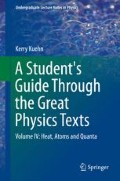Abstract
Compton’s academic career was largely devoted to the study of x-rays and their interaction with matter. X-rays had been discovered in 1895 by William Röntgen while passing an electrical current through an evacuated glass Crookes tube. The tube, he surmised, was emitting invisible rays which could penetrate a heavy black cardboard shield and cause a distant screen to glow with a fluorescent light. Almost immediately, the usefulness of these new highly-penetrating rays was recognized, and they were soon employed for medical diagnostic purposes. In fact, the earliest x-ray images are of Röntgen’s wife’s hand—revealing her skeleton beneath a thin shadow of flesh. The true nature of x-rays, however, remained a mystery until 1912, when Max von Laue discovered that they exhibit a diffraction pattern when passed through a copper sulfate crystal. This confirmed that the mysterious x-rays were indeed electromagnetic waves with lengths comparable to the atomic spacing of the crystal. Inspired by von Laue’s work, William Henry Bragg and his son, William Lawrence Bragg, carried out a systematic investigation of crystal structures using the new technique of x-ray diffraction.
But are these x-rays truly waves? Since Einstein’s 1905 publication, theoretical and experimental evidence was beginning to suggest that light behaves—at least in certain situations—like discrete packets of energy. Could this quantum theory of light be extended to x-rays? And if so, how could it be experimentally verified? These are the issues which Compton addresses in the reading selection contained in the next two chapters.
Whatever we may find regarding the nature of x-rays, it would take a bold man indeed to suggest, in light of these experiments, that they differ in nature from ordinary light.
—Arthur Holly Compton
Access this chapter
Tax calculation will be finalised at checkout
Purchases are for personal use only
Notes
- 1.
An English translation by Arthur Stanton of Röntgen’s 1895 German publication can be found in Röntgen, W. C., On a New Kind of Rays, Nature, 3(59), 277–231, 1896.
- 2.
Laue, M., Concerning the detection of X-ray interferences, in Nobel Lectures, Physics 1901–1921, Elsevier Publishing Company, 1914.
- 3.
Lawrence, B. W., The diffraction of X-rays by crystals, in Nobel Lectures, Physics 1901–1921, Elsevier Publishing Company, 1915.
- 4.
For Einstein’s introduction of the photon concept, see Chap. 16 of the present volume.
- 5.
W. Röntgen, Sitzungber. der Wurzburger Phys. Med. Ges. Jahrg. 1895. These papers are reprinted in German in Ann. d. Phys., 64, p. 1; 1898, and in English translation by A. Stanton in Science, 3, p. 227; 1896.
- 6.
C. G. Barkla, Phil. Mag., 31, p. 257; 1916.
- 7.
W. Stenstrom, Dissertation, Lund, 1919.
- 8.
Duane and Patterson, Phys. Rev., 16, p. 532; 1920. M. Siegbahn, C. R., 173, p. 1350; 1921; 174, p. 745; 1922.
- 9.
A. H. Compton , Phil. Mag., 45. p. 1121; 1923.
- 10.
R. L. Doan, Phil. Mag., 20, p. 100; 1927.
- 11.
Larsson, Siegbahn and Waller, Naturwiss, 1924.
- 12.
E. Wiechert, Sitz. d. Phys-okon Ges. zu Konigsberg, 1894.
- 13.
Haga and Wind, Wied. Ann., 68, p. 884; 1899.
- 14.
A. Sommerfeld, Phys. ZS., 2, p. 59; 1900.
- 15.
Walter and Pohl, Ann. der Phys., 29, p. 331; 1909.
- 16.
P. P. Koch, Ann. der Phys., 38, p. 507; 1912.
- 17.
A. Sommerfeld, Ann. der Phys., 38, p. 473; 1912.
- 18.
B. Walter, Ann. der Phys., 74, p. 661; 1924; 75, Sept. 1924.
- 19.
Millikan, Bowen, Sawyer, Shallenberger, Proc. Nat. Acad., 7, p. 289; 1921; Phys. Rev., 23, p. 1; 1924.
- 20.
N. Carrara, N. Cimento, 1, p. 107; 1924.
- 21.
A. H. Compton and R. L. Doan, Proc. Nat. Acad., 11, p. 598; 1925.
- 22.
J. Thibaud, C. R., Jan. 4,1926.
- 23.
Siegbahn and Thoraeus, Arkiv f M. o F., 19, p. 1; 1925.
- 24.
J. Thibaud, J. de Phys. et Rad., 8, p. 15; 1927.
- 25.
A. Dauvillier, C. R., 182, p. 1083; 1926.
- 26.
A. Dauvillier, J. de Phys. et Rad., 6, p. 1; Jan. 1927.
- 27.
T. H. Osgood, Nature, 119, p. 817; June 4,1927; Phys. Rev., November, 1927.
- 28.
F. L. Hunt, Phys. Rev., Sept. 1927.
Author information
Authors and Affiliations
Corresponding author
Rights and permissions
Copyright information
© 2016 Springer International Publishing Switzerland
About this chapter
Cite this chapter
Kuehn, K. (2016). X-Ray Diffraction. In: A Student's Guide Through the Great Physics Texts. Undergraduate Lecture Notes in Physics. Springer, Cham. https://doi.org/10.1007/978-3-319-21828-1_24
Download citation
DOI: https://doi.org/10.1007/978-3-319-21828-1_24
Published:
Publisher Name: Springer, Cham
Print ISBN: 978-3-319-21827-4
Online ISBN: 978-3-319-21828-1
eBook Packages: Physics and AstronomyPhysics and Astronomy (R0)

